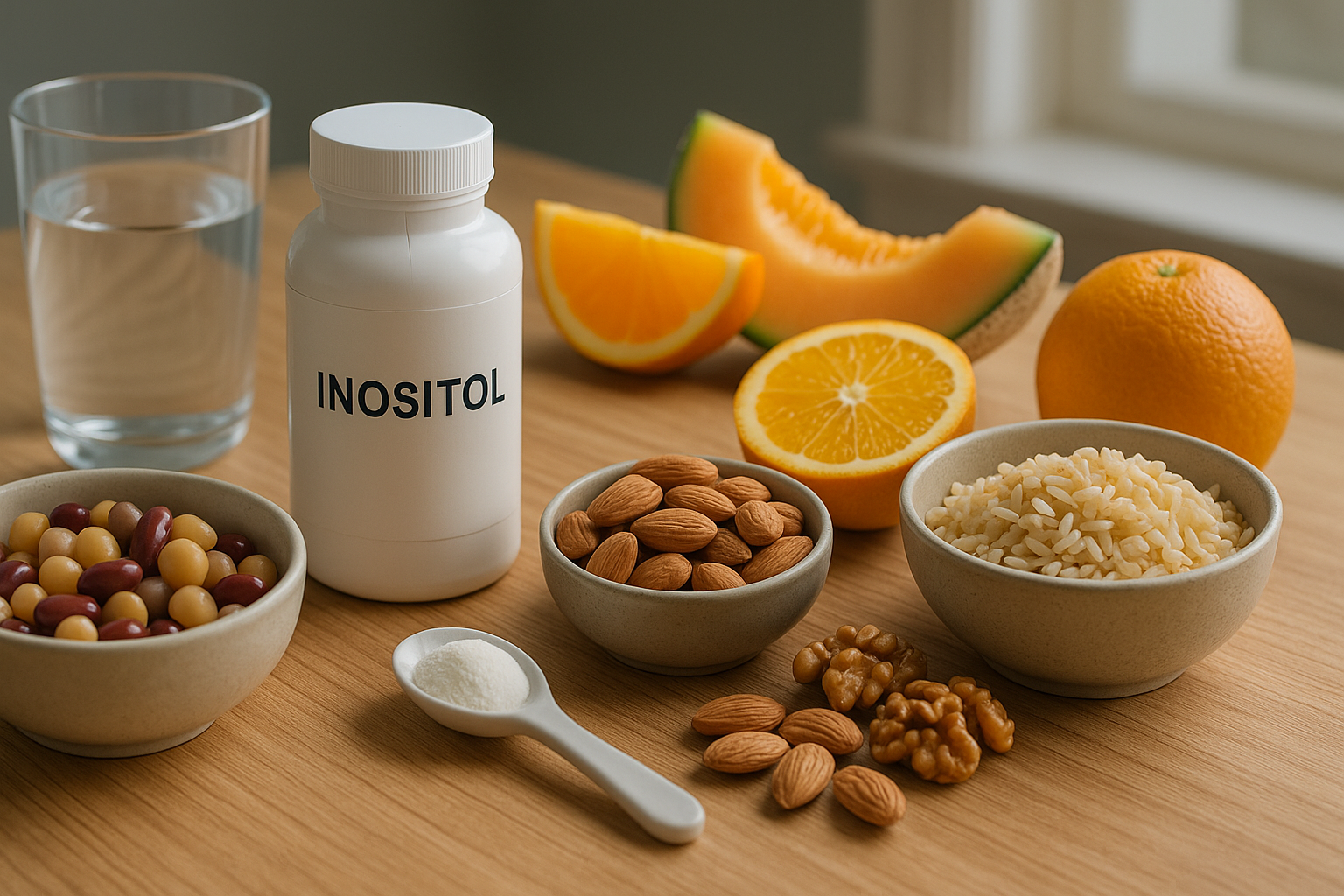Inositol and Weight Loss – What the Evidence Really Says
What Is Inositol?
Inositol is a sugar-like compound your body makes and you also get from foods such as beans, grains and fruit. Supplements usually use two forms – myoinositol (MI) and D-chiroinositol (DCI). They act inside cells as messengers for hormones, including insulin. That’s the simple story, and it matters for weight because insulin signalling touches appetite, glucose control and fat storage.
How Could It Help With Weight?
The pitch is straightforward: improve insulin sensitivity, steady blood sugar, curb hunger a little. There’s clinical support in insulin-resistant settings. For example, a randomised trial in gestational diabetes found myoinositol (4 g/day) improved insulin resistance and raised adiponectin – a hormone tied to better metabolic health. Possibly that’s one reason some people notice easier appetite control.
What Does the Research Say About Weight Loss?
Here’s the uncomfortable truth – effects on body weight are real but modest.
- A 2022 meta-analysis of 15 trials reported a small reduction in BMI with inositol versus control (weighted mean difference – 0.41 kg/m²). Useful, but not dramatic.
- In polycystic ovary syndrome (PCOS), evidence is stronger: a 2023 meta-analysis of 26 RCTs showed BMI fell more with inositol than placebo (mean difference – 0.45 kg/m²). Myo-inositol specifically showed a slightly larger drop (- 0.71 kg/m²). Benefits also appeared in glucose markers and androgens. Still, we’re talking centimetres, not clothing sizes.
If you’re expecting results like GLP-1 medicines, you’ll be disappointed. If you’re aiming for a nudge in the right direction, especially with PCOS or insulin resistance – this fits.
Who Might Benefit Most?
People with features of insulin resistance often do best in studies – PCOS, gestational diabetes, sometimes metabolic syndrome. Outside those groups, data are thinner and the size of effect shrinks. I’m not saying “don’t try it”. I’m saying set expectations low and build the basics around it.
Dosing and Forms
Most trials used myoinositol at 2 g twice daily (total 4 g/day). Some combine MI and DCI in a 40:1 ratio; evidence still leans toward plain MI for metabolic outcomes. High-dose MI (around 12 g/day) can cause gut upset – not worth it for weight. If you’re going to test it, start with the studied doses, give it 8–12 weeks, then judge.
Foods to Boost Your Intake
You don’t have to live on powders or pills. Inositol shows up in everyday food, and, honestly, that’s the easiest win. Classic food surveys found the richest sources in fruits, beans, grains and nuts, with fresh produce tending to edge out canned or frozen. Your body also makes some inositol on its own, but diet can still nudge things in the right direction.
Good food sources to keep in rotation:
- Fruits – oranges, grapefruit, melon (especially cantaloupe).
- Legumes and pulses – beans and peas in all their forms.
- Whole grains – oats, whole-wheat breads, brown rice, bran-heavy cereals.
- Nuts and seeds – almonds, walnuts; peanut butter counts too.
- Other everyday sources – corn and a range of meats also contribute smaller amounts.
Simple ways to use them
- Stir citrus segments or diced cantaloupe through yoghurt, quick breakfast, no drama.
- Build a bean and whole-grain rice salad – olive oil, lemon, herbs.
- Go for oats or high-bran cereal, then add almonds or walnuts on top.
- Swap to whole-wheat toast with peanut butter when you need a fast snack.
A quick caution that keeps things honest: a lot of plant inositol is stored as phytic acid in grains and legumes. Our gut microbes can release some of it, but the yield varies. Soaking, sprouting or fermenting may change how much is available, yet the net effect isn’t identical for every food. In short: eat these foods plus your supplement.

Safety and Side Effects
Inositol is generally well tolerated. The most common issues are nausea, bloating or diarrhoea, usually at higher doses and typically mild. If you take medications that affect glucose, speak to your clinician first – you don’t want unexpected dips. Pregnancy and long-term use deserve medical advice as standard.
How to Use It Well
Do this:
- Pair it with a protein-rich, high-fibre diet and regular movement – resistance work plus brisk walking is a solid base.
- Be consistent with dosing – mornings and evenings.
- Track something – waist, clothes fit, or a simple habit streak.
Avoid this:
- Dosing creep “just in case”. Your gut will complain.
- Sugary toppings to “reward” your supplement. That defeats the point.
- Using it instead of evidence-based treatment when you have diabetes or severe insulin resistance.
The PCOS Angle
PCOS is where inositol earns its keep. Trials show improvements in ovulatory cycles, androgens and metabolic markers, with side-effect rates often lower than metformin. Weight changes are small, yet the cluster of benefits adds up. If you have PCOS and struggle with standard options, inositol is a reasonable adjunct to discuss.
My Take
If you’re already dialling in sleep, protein, steps, and stress – inositol may give you that last 5% nudge. If the basics are chaos, it won’t rescue you. Honestly, I like it as an adjunct for people with PCOS or clear insulin-resistant traits. For everyone else, I’d label it “maybe” – affordable, low-risk, but not a fat-loss accelerator. You might feel steadier appetite. You might not. Test, measure, decide.
Practical Starting Plan
- Confirm your goal and timeline – slow loss is fine.
- Talk to your GP or pharmacist if you take glucose-affecting meds.
- Trial myoinositol 2 g twice daily for 12 weeks.
- Keep protein ~1.2–1.6 g/kg/day, fibre 25–35 g/day, steps 7–10k.
- Reassess: if weight or waist hasn’t budged at all, park it.

Bottom Line
Inositol is not a silver bullet for weight loss. It is a small lever that seems to help most in insulin-resistant states – with the best evidence in PCOS, and it’s generally safe at studied doses. Use it as part of a bigger plan, not instead of one.
